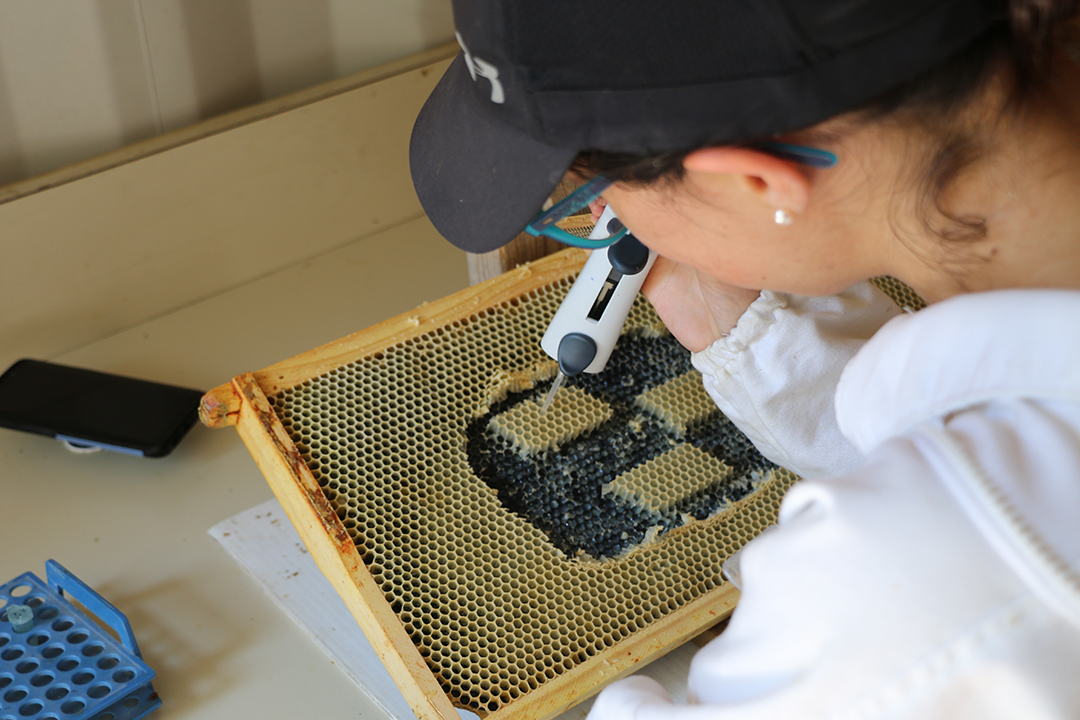
Does blueberry pollen diet make honey bees more prone to disease?
Did you know that honey bees and humans face similar challenges when it comes to diet and health? Just as people require proper nutrition to stay healthy, bees also need an ample supply of their primary food and protein source — flower-collected pollen.
By Brandele BrownEven when the pollen supply is adequate, different types of pollen have different levels of protein, and honey bee colonies that collect low-protein pollen may become stressed and vulnerable to diseases. European foulbrood disease (EFB), which infects honey bee larvae, is one particular threat.
“EFB is caused by the bacterium Melissococcus plutonius. It acts a lot like a parasite as it sets up camp in the gut of the developing bee larva and consumes all the nutrition from food before the larvae ever get a chance to absorb it,” says Dr. Ivanna Kozii, a veterinary pathologist at Prairie Diagnostic Services who recently completed her PhD degree at the Western College of Veterinary Medicine (WCVM).
Kozii, who is part of the college’s honey bee health research team, is exploring a potential link between pollen type and the prevalence of EFB. Specifically, she and her research colleagues are investigating whether there’s a correlation between blueberry pollen and increased EFB infection rates.
Since numerous beekeepers have reported an increase of EFB occurrence in hives subsisting solely on blueberry pollen, the researchers aim to compare the susceptibility of hives that are fed blueberry pollen compared to those fed multi-floral pollen — a mixture of different pollen types from a variety of plants.
“We know that the pollen from blueberry flowers has lower acidity and lower protein content than other floral sources that bees often tend to prefer over blueberries,” explains Kozii.
Using an in-hive model, Kozii and her research team work with three groups of four-day-old honeybee larvae — a control group, a group inoculated with a low dose of M. plutonius, and a group inoculated with a high dose of M. plutonius.
An equal number of these inoculated larvae are then placed into a hive that’s fed blueberry pollen or a hive that’s fed multi-floral pollen.
While the bees in these model hives are free to fly in and out of their hives, each hive entrance is outfitted with pollen excluders that prevent the bees from bringing outside pollen into the hive. As a result, the nurse bees are forced to feed the larvae only the pollen that’s been provided.
On day 10 of larval development, the researchers determine larval survival within the blueberry pollen test hive compared to that within the multi-floral pollen test hive. By comparing the survival rates, Kozii and her team can determine whether the test hives fed blueberry pollen have poorer outcomes when they’re infected with EFB.
Since blueberries are Canada’s largest fruit export, the impact of blueberry pollination on honey bee health is a key concern, especially as EFB becomes increasingly prevalent in Canada.
At one time the bee community considered EFB a self-limiting disease that only affected colonies after they had encountered secondary stressors such as shortages of pollen or worker bees.
However, that perspective is shifting.
“Nowadays, an increasing number of EFB cases don’t follow the general rules of EFB disease, and more and more beekeepers are reporting EFB incidences that persist or affect otherwise healthy, strong, vigorous hives,” says Kozii.
Researchers at the WCVM are focused on determining what is behind the increasing incidence of EFB disease — whether it be pollen type, bee population density or other factors.
The disease threatens honey bee populations and the pollination they provide — honey bees are vital not only for the production of blueberries but also for the production of many other food crops.
“To solve the problem, we must first recognize the cause,” says Kozii. “Once we find that cause we can start brainstorming solutions. But without a clear cause it’s just a guessing game.”
Brandele Brown of Pense, Sask., is a third-year veterinary student at the Western College of Veterinary Medicine (WCVM) who worked as a summer research student in 2021. Her story is part of a series of articles written by WCVM summer research students.
